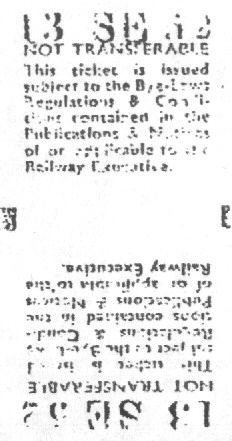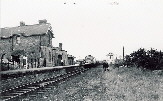
Thanks to Mr. Andrew Barnes, Director of the
Bure Valley Railway for the follwoing more detailed information on this line.
|
The line was opened by the East Norfolk Railway Company in stages. The
Company never had much money and the line was built cheaply in an effort
to save money - hence the number of steep gradients (in railway terms)
This saved the cost of deep cuttings or embankments although the line
still has these.
The line was opened in phases eventually reaching Aylsham. The original
line had intermediate stations at Coltishall and Buxton. The halt at
Brampton was only opened by the Bure Valley Railway.
The line was then extended from Aylsham to Cawston and Reepham and
eventually it made a junction with the line that ran from Wymondham to
Wells Next the sea. The junction was at County School.
As the line had little money it was soon taken over by the much larger
Great eastern Railway and that in turn in 1923 became part of the LNER -
London North Eastern Railway. In turn this became part of British
Railways upon nationalisation in 1948.
The lines operating to Melton constable were operated by the Midland and
Great Northern Joint Railway. This was a joint venture owned in equal
share by the Midland Railway and the Great Northern Railway. This line
ran nominally from Peterborough to Great Yarmouth, but also had lines
into Norwich and Sheringham.
That from Sheringham to Holt is now the North Norfolk Railway "The Poppy
line."
The line which ran from Melton Constable to Norwich crossed the Wroxham
to County School line at Themelthorpe, but there was no connection.
In 1952 the vast majority of the Midland and Great Northern sytem was
closed entirely - the same time as passenger services were withdrawn on
the line through Buxton.
As British Rail had a contract to supply coal to Norwich city Station
(Where Halfords now is in Norwich) they had to keep the line from
Themlethorpe to Norwich open and so put in a short curved spur to
connect with the line from Wroxham.
Trains with Coal from the midlands then ran to Norwich Thorpe station
then on through Wroxham Buxton, Aylsham Cawston and Reepham passing over
the new spur at Themlethorpe and on into Norwich. At this time the line
between Themlethorpe and County School was closed and track lifted.
Similarly the line north of Themlethorpe to Melton Constable was also
closed and track lifted.
In practice trains were travelling 44 miles to move coal from Norwich
Thorpe to Norwich City - 1.8 miles as the crow flies. The coal contract
was quickly lost. The line from Norwich city out as far as Lenwade was
closed.
The line from Lenwade to Themlethorpe and then on via Aylsham and Buxton
to Wroxham remained open until 1982 to take Concrete Beam out from a
works at Lenwade. These were primarily used in bridge construction.
With the closure of the concrete works in 1982 traffic ceased. British
Railways kept the track in place hoping for a revival, but eventually
gave up and the track from Lenwade all the way back to Wroxham was
lifted in 1984/1985.
As you can see the only tenuous link with Melton Constable was the spur
at Themelthorpe, but the line to Melton was lifted simultaneously with
the link being opened.
The line from Melton to Great Yarmouth also passed through Aylsham.
Aylsham having two stations until 1952. Totally unsustainable for a town
of only 2500 people at that time.
With the track through Buxton and Aylsham having been lifted Norfolk
County Council had a policy of converting old railway tracks into
footpaths, with this being undertaken by the District councils.
Broadland District Council, did not have the finance to do this and so
sought potential solutions. It was suggested that a narrow gauge railway
be constructed between Aylsham and Wroxham. Being the smaller gauge and
width, it would leave room for a footpath alongside.
As the railway was built by the private sector it would greatly reduce
the costs to the council of purchasing the trackbed it required for the
footpath and this is what happened.
The narrow gauge railway was built in 1989 and opened on 10th July 1990.
The railway operates entirely on a not for profit basis with no
dividends being paid to shareholders and the directors are not paid for
their services.
The railway has a small full time paid staff, but a core of active
volunteers provide a huge amount of support.
The railway now operates trains in every month of the year - daily from
28th March to 1st November in 2009.
|
|
There is a story about a farm hand who had never seen a train. He was sent over by the bailiff to see the train but as he got there it disappeared out of sight whistling as it went under the bridge.When asked if he had seen the train he said in pure Norfolk "Well I see soffin but as soon as it see me it shrieked and rushed into its burra."
|
Another story is told about the M.P for North Norfolk Noel Buxton ( later minister of Agriculture). While waiting for a train at Buxton station he sat on a sunny bank which unfortunately contained an ants' nest. The train then arrived and he got into his first class carriage and pulled the blinds down and took off his trousers to shake the ants out of the window. Just then another train passed in the opposite direction and took away the M.P.'s trousers. At Norwich the railway kindly lent him a pair of porter's trousers and he attended the House of Commons clad in this way.
(History of Red House By Derek Mellor)
|
In the old days another line ran from the old Norwich City Station to Aylsham and Melton Constable and north from there. The Aylsham station for this line, which didn't pass through Buxton, was on the old Cromer road

 One of the final tickets issued for this line.
13th September 1952.
One of the final tickets issued for this line.
13th September 1952.


|




 One of the final tickets issued for this line.
13th September 1952.
One of the final tickets issued for this line.
13th September 1952.
